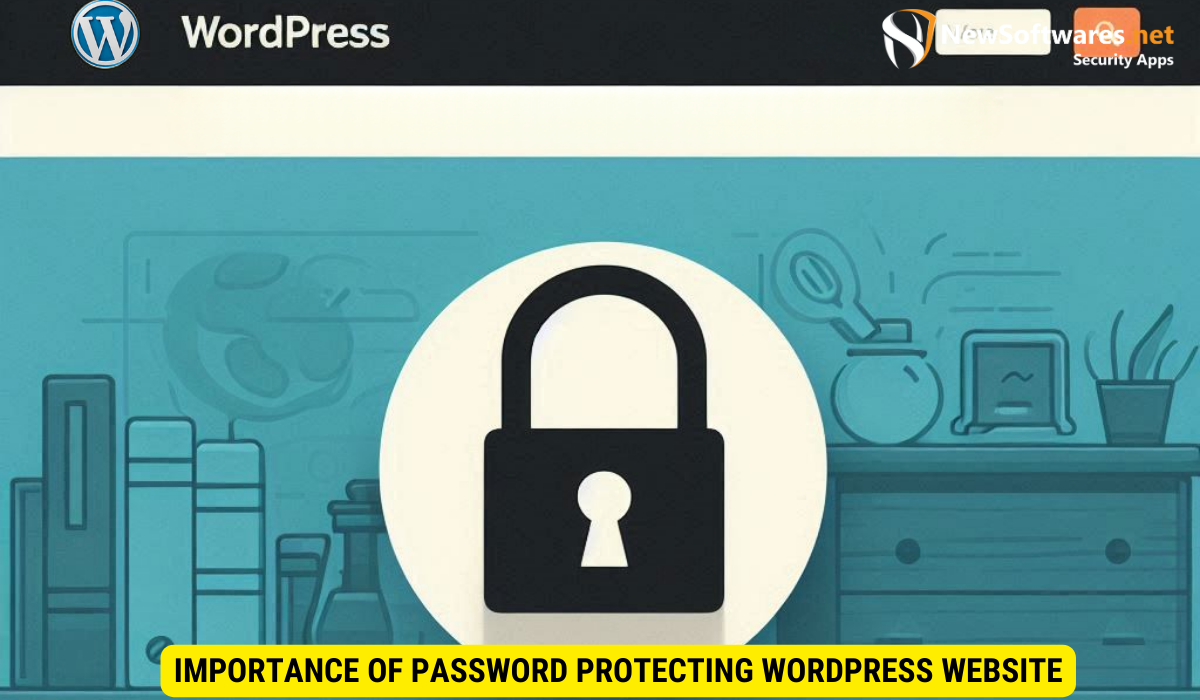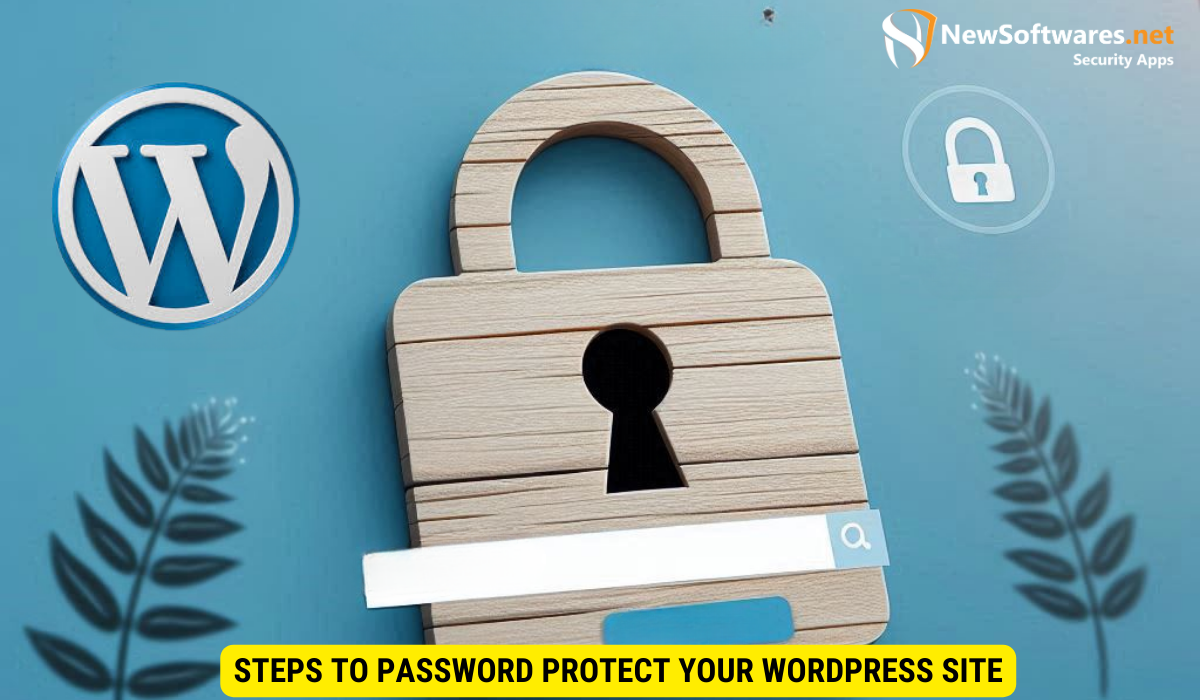To password protect a WordPress site, you can use plugins or server-level configurations. Here’s a brief guide using a plugin:
- Install a plugin like Password Protected by WPExperts.
- Go to Settings → Password Protected in your WordPress dashboard.
- Check the Password Protected Status box to enable password protection.
- Enter your desired password in the New Password box.
This setup will restrict access to your site, ensuring only users with the correct password can view your content.
In today’s digital landscape, ensuring the security of your WordPress site is of paramount importance. One effective way to safeguard your website is by password protecting it. By implementing this simple yet crucial step, you can prevent unauthorized access, safeguard your sensitive content, and give yourself peace of mind. I will delve into the process of password protecting your WordPress site, covering everything from understanding its importance to troubleshooting common issues.
Importance of Password Protecting WordPress Website

Password protection is the first line of defense for your WordPress site. It acts as a barrier that separates your valuable content from potential attackers. By requiring a password to access your site, you significantly reduce the risk of unauthorized individuals gaining entry. This extra layer of security serves as a deterrent and helps maintain the privacy and integrity of your website.
Implementing strong password protection practices involves creating unique and complex passwords that are difficult for hackers to guess. It is recommended to use a combination of letters, numbers, and special characters to enhance the security of your site. Regularly updating passwords and avoiding common phrases or easily guessable information are also crucial steps in safeguarding your online presence.
The Role of Password Protection in WordPress
In WordPress, password protection adds an additional layer of security to individual pages or posts. When enabled, visitors must enter a password to view the protected content. This feature is especially useful for sensitive information or materials that are intended for a limited audience.
Furthermore, WordPress offers the flexibility to set different passwords for various pages or posts, allowing you to customize access levels based on your content’s sensitivity. This granular control ensures that only authorized users can view specific information, enhancing the overall security of your website.
Risks of Not Password Protecting Your Site
Failure to password protect your WordPress site can have severe consequences. Without this security measure in place, anyone can access your content, potentially compromising your intellectual property, customer data, or confidential information. Additionally, leaving your site vulnerable increases the risk of malware infections, data breaches, and other cyber-attacks.
It is essential to prioritize password protection as part of your overall security strategy to mitigate these risks effectively. By proactively securing your site with robust passwords and access controls, you can safeguard your data and prevent unauthorized access, ensuring a safe and secure online environment for both you and your visitors.
Steps to Password Protect Your WordPress Site

Choosing the Right Password Protection Plugin
The first step in password protecting your WordPress site is to choose a reliable password protection plugin. There are several options available, each with its own set of features and capabilities. Research and select a plugin that aligns with your specific needs and requirements.
Consider factors such as ease of use, compatibility with your WordPress version, frequency of updates, and customer reviews when making your decision. Some popular password protection plugins include “Password Protect WordPress” and “Ultimate Member.”
Setting Up User Accounts and Passwords
Once you have chosen a password protection plugin, the next step is to set up user accounts and passwords for your site. Create unique usernames and strong, complex passwords for each user. Remember to communicate these login credentials securely to authorized individuals only.
It is advisable to implement a password policy that includes requirements such as minimum password length, the use of special characters, and regular password updates. This helps enhance the security of your WordPress site and reduces the risk of unauthorized access.
Advanced Password Protection Techniques
Implementing Two-Factor Authentication
Two-factor authentication (2FA) is an additional security measure that adds an extra layer of protection to your WordPress site. It requires users to provide two forms of authentication, typically a password and a unique code sent to their mobile device. Enabling 2FA significantly reduces the risk of unauthorized access.
Moreover, two-factor authentication is highly recommended for websites that handle sensitive information such as financial data or personal details. By implementing 2FA, you are not only safeguarding your site but also protecting the privacy and security of your users, building trust and credibility in your online platform.
Using .htaccess for Additional Security
Another advanced technique to enhance password protection is by utilizing the powerful .htaccess file. This file resides on your web server and allows you to define access rules. With .htaccess, you can restrict IP addresses, block specific user agents, or even enforce HTTPS encryption. These measures further strengthen the security of your protected WordPress site.
Furthermore, .htaccess can be used to set up custom error pages, optimize website performance by enabling caching, and prevent hotlinking of your images. By leveraging the capabilities of .htaccess, you not only enhance the security of your WordPress site but also improve its overall functionality and user experience.
Maintaining Your Password Protected WordPress Site
Regularly Updating Your Passwords
As an ongoing practice, it is crucial to periodically update your passwords. Regularly changing your passwords helps prevent potential breaches, as it mitigates the risk of compromised login credentials. Consider establishing a password update policy and informing your users accordingly.
Furthermore, when updating passwords, ensure that the new passwords are complex and unique. Avoid using easily guessable information such as birthdays or common words. Implementing two-factor authentication can add an extra layer of security to your WordPress site, making it even more resilient against unauthorized access.
Monitoring for Unauthorized Access
Keep a vigilant eye on your password protected WordPress site for any signs of unauthorized access or suspicious activity. Utilize security plugins and monitoring tools to receive alerts and log access attempts. By staying proactive, you can respond promptly to any potential security threats.
In addition to monitoring tools, consider conducting regular security audits to identify any vulnerabilities in your WordPress site. These audits can help you pinpoint weak spots that may be exploited by malicious actors. By addressing these vulnerabilities promptly, you can enhance the overall security posture of your website and protect sensitive data from being compromised.
Troubleshooting Common Password Protection Issues
Ensuring the security of user accounts is crucial in maintaining a safe online environment. When users encounter issues with password protection, it can lead to frustration and hinder their experience on your platform. By addressing common problems effectively, you can enhance user satisfaction and trust in your system.
Resetting Forgotten Passwords
Occasionally, users may forget their passwords, causing access issues. To resolve this, provide a password reset functionality on your login page. Alternatively, as an Administrator, you can reset passwords for users manually through the WordPress dashboard. It is essential to educate users on the importance of creating strong, memorable passwords to reduce the likelihood of forgetting them. Additionally, consider implementing multi-factor authentication to add an extra layer of security to user accounts.
Dealing with Locked Out Accounts
If an account becomes locked due to multiple failed login attempts, it can be frustrating for the user. Be prepared to assist locked-out users by providing clear instructions on how to regain access to their accounts. This may involve verifying their identity through additional means, such as email or phone verification. Communicate proactively with users about account lockout policies and encourage them to reach out for support if needed. Regularly review and update your security protocols to prevent unauthorized access attempts and protect user data effectively.
Key Takeaways
- Implementing password protection strengthens the security of your WordPress site.
- Choose a reliable password protection plugin that suits your needs.
- Set up user accounts and passwords securely.
- Consider advanced techniques like two-factor authentication and .htaccess rules for enhanced security.
- Maintain your site by regularly updating passwords and monitoring for unauthorized access.
FAQs
1. Can I password protect specific pages or posts in WordPress?
Yes, WordPress allows you to password protect individual pages or posts. This feature helps you selectively restrict access to specific content, ensuring only authorized individuals can view it.
2. What makes a strong password?
A strong password typically consists of a combination of uppercase and lowercase letters, numbers, and special characters. It should be unique, lengthy, and easy to remember for the user while being difficult for others to guess or crack.
3. Is password protecting my WordPress site enough to ensure complete security?
Password protecting your WordPress site is an essential security measure, but it should not be the only one. Implementing additional security measures such as regular updates, security plugins, and monitoring for suspicious activity will further enhance your site’s security.
4. Can I use plugins for two-factor authentication in WordPress?
Yes, there are several plugins available that enable two-factor authentication in WordPress. These plugins make it easy to add an extra layer of security to your login process, enhancing the overall protection of your WordPress site.
5. What should I do if I suspect unauthorized access to my password protected WordPress site?
If you suspect unauthorized access to your password protected WordPress site, take immediate action. Change all passwords, review your site’s security logs, and consider consulting with a security professional to evaluate and mitigate any potential risks.
Conclusion
Securing your WordPress site with password protection is a crucial step in safeguarding your content and sensitive information. By understanding the importance of password protection and following the steps outlined above you can ensure the security of your WordPress site and protect it from potential threats. Remember that security is an ongoing process, and staying proactive is key to maintaining a secure environment for your website and its users.
